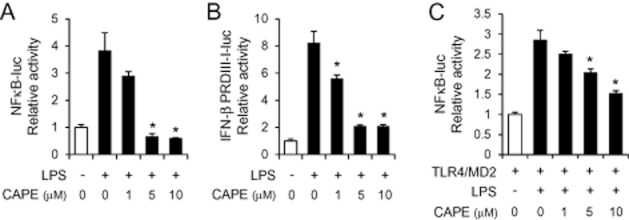Figure 4.

Caffeic acid phenethyl ester (CAPE) prevents TLR4 ligand lipopolysaccharide (LPS)-induced activation of NFκB and IRF3. (A, B) RAW264.7 cells were transfected with a luciferase reporter plasmid containing NFκB binding sites (NFκB-luc) or IRF3 binding domain derived from the IFN-β promoter (IFN-β PRDIII-I-luc). (C) 293T cells were transfected with the expression plasmids for TLR4 and MD2 along with NFκB-luc. Cells were pre-treated with CAPE (1, 5 and 10 μM) for 1 h, and then stimulated with LPS (10 ng mL−1) for an additional 8 h. Cell lysates were analysed for luciferase and β-galactosidase activities. Relative luciferase activity was calculated after normalization with β-galactosidase activity. Values are means ± SEM (n = 3). *Significantly different from LPS alone, P < 0.05.
